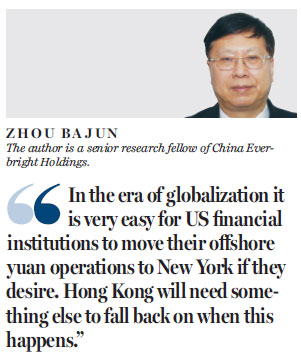Challenges facing Hong Kong as the leading offshore renminbi trade hub
Updated: 2016-06-15 08:04
By Zhou Bajun(HK Edition)
|
|||||||||
The 13th Five-Year Plan (2016-20) includes continued support for Hong Kong to strengthen its status as the leading offshore yuan trade hub and a key international asset management center. Two recent developments are posing challenges as well as creating opportunities for Hong Kong in this regard.
The People's Bank of China (PBOC) announced on June 7 that China had decided to grant US banks an annual quota of 250 billion yuan ($38 billion) to invest on the Chinese mainland along with the status of Renminbi Qualified Foreign Institutional Investor (RQFII). This means there will be American banks authorized to do yuan clearing in the US in future.
As of May 30, the mainland has granted 16 countries and regions a total of 1.21 trillion yuan in RQFII quotas. Hong Kong leads them with 270 billion yuan, followed by South Korea with 120 billion and Singapore in third place with 100 billion. The UK, Germany and France have 80 billion yuan each in RQFII quota while Canada has 50 billion. These economies differ significantly in how much of their RQFII quotas they use every year. As of May 30, the mainland has granted a total of 501.77 billion yuan in RQFII quotas for this year. But only Hong Kong has used all the 270 billion yuan at its disposal. Canada has used just 1.83 billion yuan, or less than 4 percent, of its quota. That is why it came as a surprise when the mainland granted the US 250 billion yuan in RQFII quotas from the beginning - behind only Hong Kong. This decision underlines the importance China attaches to financial cooperation with the US. It also signals the possible rise of New York City in the not-too-distant future as a strong competitor to Hong Kong for the title of "leading offshore yuan trade hub of the world".
The US is dealing with China's economic rise by using two tactics - on the one hand denying China a role in writing the rules for international trade and investment by shutting the latter out of the Trans-Pacific Partnership (TPP) and Trade in Services Agreement (TISA), while on the other hand luring China into the US-led international currency and banking playground. The "keep your enemy closer" approach in financial affairs was first observed in November last year, when Washington agreed to include renminbi in the basket of major currencies in international trade known as special drawing rights (SDR) currencies. The recent acceptance of the second-largest RQFII quota is further proof of this tactic.
The reason why the US is blocking China's participation in the global economy and physical trade activities is that the Chinese economy is already a formidable competitor. It is now the second largest in the world after the US, but more importantly No 1 in the trade of goods. The US is luring China into the international currency and banking system because the latter is still new to the game and its currency, the yuan, is not yet fully convertible. Right now the renminbi's market share of foreign trade clearance is less than 2 percent. Following this two-pronged strategy on China there is good chance that New York City will become another offshore yuan trade hub in the future.
Hong Kong's financial markets are dominated by American conglomerates, while US-owned financial institutions and other firms account for a sizable portion of offshore yuan trade in the SAR. In the era of globalization it is very easy for US financial institutions to move their offshore yuan operations to New York if they desire. Hong Kong will need something else to fall back on when this happens.
The Legislative Council (LegCo) did the right thing in passing an amendment to the Inland Revenue Ordinance (IRO) on May 26 that will cut the profits tax rate for qualifying corporate treasury centers from 16.5 percent to 8.25 percent from April 1. This is designed to lure multinational enterprises to establish their corporate treasury centers in Hong Kong. Such facilities will no doubt boost demand for banking, finance, risk management, tax-related assistance and legal counsel services.
Neither the decision-makers behind the amendment of the IRO nor LegCo could have anticipated the central government's decision to grant the US so much in RQFII quotas. But that they cut the profits tax rate for corporate treasury centers is a welcome coincidence in Hong Kong's favor. This should help the city remain the preferred location for mainland companies requiring financing services even if some or most of the US providers move their offshore yuan trade operations to New York now or sometime soon. The reality is there is no better place than Hong Kong when it comes to finance and related services for companies doing business with the Chinese mainland and mainland enterprises seeking to "go abroad".

(HK Edition 06/15/2016 page12)